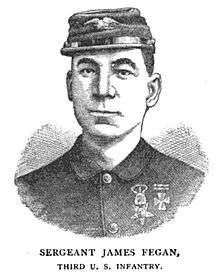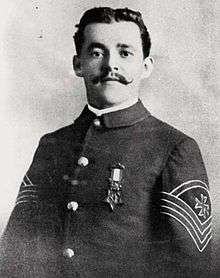3rd U.S. Infantry Regiment (The Old Guard)
| 3rd United States Infantry Regiment | |
|---|---|
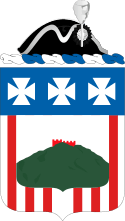 3rd Infantry Regiment coat of arms | |
| Active |
3 June 1784 – 20 November 1946 6 April 1948 – present |
| Country |
|
| Branch |
|
| Type | Infantry |
| Role |
Memorial affairs, ceremonies and special events (two battalions) Stryker infantry (one battalion) |
| Size | Four battalions (three active) |
| Garrison/HQ |
1st Battalion – Fort Myer, VA 2nd Battalion – Fort Lewis, WA 4th Battalion – Fort Myer |
| Nickname(s) | "The Old Guard"[1] |
| Motto(s) | Noli Me Tangere (English: Touch Me Not) |
| Colors | Buff and black (historical)[2] |
| March | The Old Guard March[3] |
| Anniversaries | 21 September-Organization Day |
| Engagements |
|
| Website | http://www.oldguard.mdw.army.mil/ |
| Commanders | |
| Current commander | COL James J. Tuite IV[4] |
| Notable commanders |
LTC Paul Octave Hébert COL Henry Leavenworth LTC Ethan A. Hitchcock COL Benjamin Bonneville |
| Insignia | |
| Distinctive unit insignia |
 |
| Combat Service Identification Badge |
 |
| Distinctive Trimming (Buff Strap) |
|
U.S. Infantry Regiments | |
|---|---|
| Previous | Next |
| 2nd Infantry Regiment | 4th Infantry Regiment |
The 3rd United States Infantry Regiment is a regiment of the United States Army. It currently has three active battalions, and is readily identified by its nickname, "The Old Guard," as well as "Escort to the President". The regimental motto is Noli Me Tangere (from Latin: – "Touch Me Not"). The regiment is a major unit of the Military District of Washington (MDW).
The regiment is the oldest active duty regiment in the US Army, having been first organized as the First American Regiment in 1784.[5][6]
Mission
The regiment's mission is to conduct memorial affairs to honor fallen comrades and ceremonies and special events to represent the U.S. Army, communicating its story to United States citizens and the world.
Although The Old Guard primarily functions in a ceremonial role, it is an infantry unit and thus required to meet standards for certification in its combat role. The unit also trains for its support role to civil authorities in a wide range of scenarios and for deployments in support of overseas contingency operations. On order, it conducts defense support of civil authorities in the National Capital Region and deploys elements in support of overseas contingency operations.[4][7]
Memorial affairs and ceremonial mission
.jpg)
Memorial affairs missions include standard and full honors funerals in Arlington National Cemetery and dignified transfers at Dover Air Force Base. Old Guard soldiers also perform all dignified transfers of fallen soldiers returning to the United States.[8]
The Old Guard's ceremonial task list includes full honor arrivals for visiting dignitaries, wreath ceremonies at the Tomb of the Unknowns, and full honor reviews in support of senior army leaders and retiring soldiers. Special events include the Twilight Tattoo, a weekly performance in the adjacent Washington area on Wednesday evenings from May to July, and the Spirit of America, a historical pageant presented at three national venues in September.
The Old Guard is the only unit in the U.S. Armed Forces authorized, by a 1922 decree of the War Department, to march with fixed bayonets in all parades.[9] This was granted in honor of the 1847 bayonet charge by the regiment during the Battle of Cerro Gordo in the war with Mexico.
Specialty units
In addition to the marching platoons, there are also elements of The Old Guard that serve special roles unique both to the regiment as well as the US Army. Among these include the sentinels of the Tomb of the Unknown Soldier, maintaining a twenty-four-hour watch over one of the nation's most sacred sites; the Continental Color Guard, which presents the nation's colors at special events across the Capitol Region; the Presidential Salute Battery, which renders honors to senior dignitaries at arrival and wreath ceremonies, reviews, and full honors funerals; and the US Army Caisson Platoon, which provides horses and riders to pull the caisson (the wagon that bears a casket) in military and state funerals.
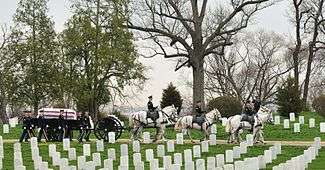
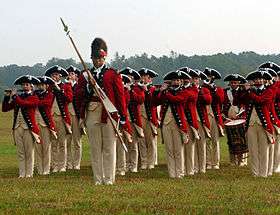
The Caisson Platoon also provides the riderless horses used in full honors funerals and supports wounded warriors participating in the Therapeutic Riding Program. Other elements of The Old Guard include the Commander-in-Chief's Guard (Company A), replicating the personal guard of General George Washington; wearing Colonial blue uniforms, powdered wigs, and tricorn hats; and bearing Brown Bess muskets and halberds at ceremonies and special events; the US Army Drill Team, which demonstrates its skill and precision around the nation, and Old Guard Fife and Drum Corps, which plays traditional arrangements of marching music, dating back to the time of the Continental Army. The Old Guard Fife and Drum Corps marches in Colonial style red coated uniforms—to be "better seen through the smoke of battle"; the uniforms also include tricorn hats and white powdered wigs. The drum major of the Fife and Drum Corps traditionally bears an espontoon[10] (a historic pike-like weapon) in his right hand to direct and command his unit.[10] As such, he is the only soldier in all the U.S. Armed Forces authorized to bear a spontoon and to salute with the left hand[11] (although U.S. Navy personnel are allowed to salute with the left hand under certain conditions).[12] Rounding out The Old Guard are the 289th Military Police Company, the 947th Military Working Dog Detachment, the 529th Regimental Support Company, two battalion headquarters companies, and the regimental headquarters company.
Unique badges awarded to specific members of "The Old Guard"
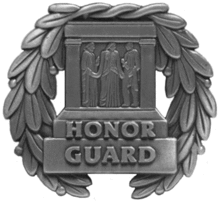 Guard, Tomb of the Unknown Soldier Identification Badge, awarded to eligible sentinels from the Tomb Guard Platoon
Guard, Tomb of the Unknown Soldier Identification Badge, awarded to eligible sentinels from the Tomb Guard Platoon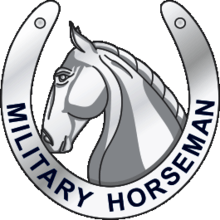 Military Horseman Identification Badge, awarded to eligible horseman from the Caisson Platoon
Military Horseman Identification Badge, awarded to eligible horseman from the Caisson Platoon
Escort Platoon
Escort Platoon is a term referring to a platoon of soldiers in the U.S. Army's 3rd Infantry Regiment whose primary ceremonial mission is to march in ceremonies or military funerals. Generally, line infantry companies delegate the escort role to their 1st platoon. This platoon is generally composed of the tallest soldiers assigned to the unit.
The regiment's Presidential Escort Platoon, Honor Guard Company, is based at Fort Myer.[13] A former member of the platoon who served in the early 2000s reported that 6 foot 5 inches was the minimum height required by the platoon at that time.[13] The platoon serves at presidential funerals, inaugurations, Pentagon retirements, state dinners and state visits at the White House, and during presidential speeches in the Rose Garden, among other duties.[13]
Current organization of the 3rd Infantry Regiment
Regimental Headquarters and Headquarters Company (RHHC)
- HHC, 3rd US Infantry Regiment (TOG):
- Headquarters Platoon
- Coordinating Staff
- RS-1 (Administration)
- RS-2 (Intelligence)
- RS-3 (Operations)
- CBRN (Chemical, Biological, Radiological, Nuclear)
- Operations
- Drafters
- RS-4 (Logistics)
- Property Book Office
- Ceremonial Equipment Branch
- RS-6 (Communications)
- Communications
- IMO (Information Management Operations)
- ROP
- Chaplains Office
- Public Affairs Office
- Regimental Recruiters
- The Old Guard Museum
1st Battalion

The battalion is composed of the following units:
- HHC, 1st Battalion, 3rd US Infantry Regiment (TOG)
- Battalion Staff Sections: (S1, S2, S3, S4, S6)
- Caisson Platoon
- Presidential Salute Battery
- Headquarters Platoon
- Bravo Company
- Escort Platoon
- Casket Platoon
- Firing Party Platoon
- Headquarters Platoon
- Charlie Company
- Escort Platoon
- Casket Platoon
- Firing Party Platoon
- Headquarters Platoon
- Delta Company
- Escort Platoon
- Casket Platoon
- Firing Party Platoon
- Headquarters Platoon
- Hotel Company
- Escort Platoon
- Casket Platoon
- Firing Party Platoon
- Headquarters Platoon
4th Battalion
From 1966 to 1974, the 4th Battalion was part of the 11th and 198th Infantry Brigades in Vietnam. The 4th Battalion was reactivated at Fort Myer in 2008.
The battalion is composed of the following units:
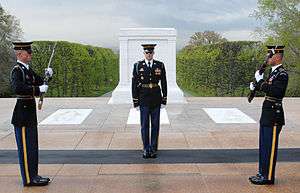
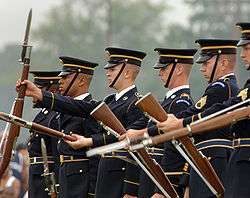
- Headquarters & Headquarters Company (HHC), 4th Battalion, 3rd US Infantry Regiment (TOG)
- Tomb Guards, the Tomb of the Unknown Soldier
- The United States Army Drill Team
- Battalion Staff Sections: (S1, S2, S3, S4, S6)
- Alpha Company (Commander-In-Chief's Guard)
- Three Colonial Marching Platoons
- Echo Company (Honor Guard Company)
- Escort Platoon
- Casket Platoon
- Firing Party
- Continental Color Guard[14]
- 289th Military Police Company
- Special Reaction Team
- 947th MP Detachment (K-9)
- The Old Guard Fife and Drum Corps
- 529th Regimental Support Company
- Headquarters Section
- Food Service Platoon
- Maintenance Platoon
- Transportation Platoon
- Medical Platoon
2nd Battalion
Stationed at Fort Lewis, Washington, the 2nd Battalion, 3rd US Infantry Regiment, serves as one of three infantry battalions of the 1st Stryker Brigade Combat Team of the 2nd Infantry Division ('Indian Head'). After a 31-year hiatus from service, the 2nd Battalion was reactivated on 15 March 2001 as part of the US Army's first Stryker brigade (inactive) combat team. It served as part of the first deployment of a Stryker brigade combat team in 2003. It then served a 15-month deployment in 2006–2007. It deployed to Iraq again in 2009 and Afghanistan in 2011. From 1966 to 1970, the 2nd Battalion was part of the 199th Light Infantry Brigade in Vietnam.
- HHC, 2nd Battalion, 3rd US Infantry Regiment
- Scout Platoon
- Mortar Platoon
- Medical Platoon
- Battalion Staff Sections: (S1, S2, S3, S4, S6)
- Alpha Company
- First Platoon
- Second Platoon
- Third Platoon
- Mortar Section
- Bravo Company
- First Platoon
- Second Platoon
- Third Platoon
- Mortar Section
- Charlie Company
- First Platoon
- Second Platoon
- Third Platoon
- Mortar Section
- Golf Company
- HQ/Field Feeding Team Platoon
- Maintenance Platoon
- Distribution Platoon
Operational history
Early years
The Old Guard traces its history to the First American Regiment organized in 1784 under command of Lieutenant Colonel Josiah Harmar, a veteran of the American Revolution. The 1st Infantry saw its first combat in an unsuccessful campaign against the Miami tribe in modern-day Ohio in 1790. This was followed by devastating losses at St. Clair's Defeat in 1791.
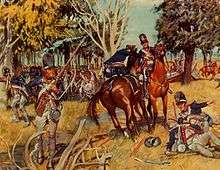
In 1792 the United States Army was reorganized into the Legion of the United States, with the 1st Infantry forming the nucleus of the 1st Sub-Legion. (Sub-Legions were the remote ancestors of today's Brigade Combat Teams, with organic Infantry, Cavalry and Artillery units.) On August 20, 1794, along with the most of the Legion's units under the command of Major General Anthony Wayne, the 1st Sub-Legion was engaged at the decisive victory of the Legion over the Miamis at the Battle of Fallen Timbers.
In 1795 the Legion was reorganized along more traditional lines and reverted to being called the United States Army. In the reorganization the 1st Sub-Legion was redesignated as the 1st Infantry Regiment.
As of 1805, six of the regiment's ten companies were in St. Louis, Missouri, with the other four located at Fort Massac, Fort Dearborn, Fort Adams, Mississippi and Fort Wayne in Detroit.
War of 1812 and reorganization of the Army
During the War of 1812 the 1st Infantry served in Upper Canada and saw action at the battles of Chippewa and Lundy's Lane.
After the end of the War of 1812 in early 1815, the Army had a total of 44 Infantry regiments which were consolidated into only eight regiments. Rather than preserving the existing designations of the Army's oldest units, it was decided instead to consolidate units based on their geographic proximity rather than seniority. This is why the 3rd Infantry is the oldest Infantry unit in the active United States Army rather than the 1st Infantry.
1815 to 1861
As of November 30, 1819, the regiment was located on the northwestern frontier at Fort Howard in Green Bay, Wisconsin. As of November 9, 1822, the regiment had 6 companies in Green Bay, two in Sarnac and two in Chicago.
The annual report of the Army from 1826 showed that the regiment had been re-located to Jefferson Barracks, Missouri.
As of November 1837 the regiment's headquarters and six companies were at Fort Jesup in Louisiana with the other four companies at Fort Towson in Arkansas.
From 1840 to 1843 the 3rd Infantry fought in the Seminole War in Florida.
During the Mexican War the regiment fought in most of the major battles of the war including Palo Alto, Monterey, the invasion and Siege of Vera Cruz, Cerro Gordo, Churubusco and Chapultepec which led to the capture and occupation of Mexico City.
From 1856 to 1860 the regiment served in New Mexico where it fought the Navajo Indian tribe.
After serving in New Mexico, the regiment was spread out to various posts on the Gulf of Mexico from Florida to Texas.
American Civil War
The 3rd Infantry saw extensive service during the American Civil War and was credited with 12 campaigns. Detachments from the regiment were serving at Fort Pickens in Florida and in Saluria on the Gulf Coast of Texas when the war began in April 1861. Three companies of the 3rd Infantry surrendered on April 25. Five of the regiment's 10 companies were engaged at the Battle of Bull Run on July 20, 1861.
The regiment spent most of the war assigned to the Army of the Potomac and served mostly in Virginia. From May 1862 to March 1864 it served with 1st Brigade, 2nd Division of the 5th Corps. In March 1864 it was reassigned to the 4th Brigade, 1st Division of the 5th Corps. It participated in the Siege of Yorktown (part of the Peninsular Campaign), the Battle of Cold Harbor, the Battle of Malvern Hill, the Second Battle of Bull Run, the Battle of Antietam, the Battle of Fredericksburg, the Battle of Chancellorsville, the Battle of Gettysburg and the Battle of Appomattox.
1865 to 1917
After the Civil War, the 3rd Infantry served in Kansas, Colorado and the Indian Territory (later the state of Oklahoma) from 1866 to 1874. It then served in Louisiana and Mississippi from 1874 to 1877 and Montana, Minnesota and South Dakota from 1877 to 1898.[15]
During the Spanish–American War, the regiment served in Cuba from June 14 to August 25, 1898, where it participated in the Santiago Campaign and fought at the Battle of San Juan Hill.[15]
After returning from Cuba, the 3rd Infantry was stationed at Fort Snelling in Minnesota. On October 5, 1898, a force of about 80 men—including soldiers of the 3rd Infantry, U.S. Marshals and Indian Police—fought in the Battle of Sugar Point against 17 members of the local Pillager Band of Chippewa Indians near the Leech Lake Reservation. The United States forces lost 6 soldiers and one Indian Police officer killed and another 14 wounded. There were no casualties among the Chippewa. Hospital Steward (later Major) Oscar Burkard received the Medal of Honor for rescuing casualties during the battle. The Battle of Sugar Point was the last battle fought between the United States Army and Native Americans.
The 3rd Infantry also served in the Philippines during the Philippine Insurrection from February 3, 1899, to April 15, 1902. It then returned to the United States where it was stationed in Kentucky, Ohio and Illinois. It was then sent to Alaska were it served from July 1, 1904, to August 6, 1906, when it was sent to Washington state until it was sent back to the Philippines about 1909.[15]
As of August 1914 the Regiment's headquarters, along with the 2nd and 3rd Battalions, were located at Madison Barracks, New York. The 1st Battalion was located at Fort Ontario, New York.[16]
Mexican Border and World War I
In 1916 the 3rd Infantry was sent, along with most of the U.S. Army, to the Mexican Border to guard against hostile insurgents as well as to deter a possible invasion by Mexico.
During World War I, the headquarters of the 3rd Infantry, along with the 3rd Battalion, was posted at Camp Eagle Pass in Texas. The 1st Battalion was located at Del Rio, Texas and the 2nd Battalion was at Fort Sam Houston. Throughout the war the regiment was assigned to patrolling the Mexican Border and did not see action.
During World War I, recent West Point graduate Captain Matthew Ridgeway was assigned to the 3rd Infantry. Ridgeway would go on to have a highly distinguished 38-year career including assignments as commander of the 82nd Airborne Division, XVIII Airborne Corps, 8th United States Army, United Nations Command Korea, Supreme Allied Commander Europe and Chief of Staff of the United States Army.
Interwar period (1919–39)
Following the establishment of the United States Border Patrol, the 3rd Infantry was relocated to Camp Sherman in Ohio on 14 October 1920. The Regiment marched 941 miles from Camp Sherman to Fort Snelling, Minnesota, arriving on 17 November 1921. Upon arrival the 2nd and 3rd Battalions were inactivated on 18 November 1921 and the 1st Battalion assumed garrison duties. The regiment was re-organized as a combat regiment when the 2nd and 3rd Battalions were re-activated on 8 June 1922.
On 24 March 1923 the regiment was assigned to the 7th Division. On 15 August 1927 the regiment was reassigned to the 6th Division.
On 1 October 1933 the regiment reverted to being assigned to the 7th Division. On 22 April 1939 the regiment conducted a review for Crown Prince Frederick and Princess Ingrid of Denmark.
World War II
During World War II, the 3rd Infantry served as a separate regiment and was not assigned to a combat division.
On 16 October 1939 it was relieved from assignment to the 7th Division and assigned to the 6th Division at Fort Jackson, South Carolina. In November 1940 the 1st Battalion was relocated to Fort Crook, Nebraska. The regiment was relieved from assignment to the 6th Division on 10 May 1941. The 3rd Battalion departed from New York on 20 January 1941 and was sent to St. Johns, Newfoundland before moving to Fort Pepperrell in the Newfoundland Base Command in November 1941.
The 1st Battalion was inactivated 1 June 1941 at Fort Leonard Wood, Missouri, with its soldiers being assigned to the 63rd Infantry and was re-activated 14 February 1942 in Newfoundland. The remainder of the regiment was sent to Camp Ripley, Minnesota, on 13 September 1941 and returned to Fort Snelling on 26 September.
When the United States declared war on Japan in December 1941 the regiment was stationed at Fort Snelling. The 2nd Battalion was inactivated 1 September 1942 at Fort Snelling.
The regiment arrived in Boston on 17 September 1943 and moved to Camp Butner, North Carolina, on 22 September 1943 where it was attached to the XII Corps. The 2nd Battalion was re-activated on 22 October 1943 at Camp Butner. The regiment was moved to Fort Benning, Georgia, on March 8, 1944, where it provided cadre for the Infantry School.
Late in the war, the regiment staged at Camp Myles Standish, near Taunton, Massachusetts, on February 27, 1945, and departed from Boston bound for France on March 8, 1945.
The regiment arrived in Le Havre, France on March 18, 1945, and was attached to the reconstituted 106th Infantry Division with the mission of containing the isolated German garrison at St. Nazaire. The regiment moved with the 106th Division into Germany on 26 April 1945 — twelve days before the surrender of Germany — and processed prisoners of war. The regiment was then assigned to duty in the occupation of Germany and was located at Babenhausen. The 3rd Infantry was inactivated on 20 November 1946 in Berlin.[17]
The 3rd Infantry was credited with the American Theater streamer for its defense of Newfoundland. For unknown reasons, it was also credited with the European Theater Northern France Campaign streamer, however, the Northern France Campaign ended on 14 September 1944 — six months before the regiment arrived in France. It appears that the regiment, instead, should have been credited with the Central Europe Campaign streamer as it was attached to the 106th Division when it entered Germany and briefly served in the campaign.
Post World War II
The 3rd Infantry Regiment (less the 2nd Battalion) was re-activated on 6 April 1948 at Fort Myer, Virginia. The 2nd Battalion was concurrently re-activated at Fort Lesley J. McNair, Washington, D.C. This was when the unit assumed the role it is best known for today as the official ceremonial unit of the United States Army. The regiment's reactivation was shortly before the state funeral of General of the Armies John J. Pershing held on July 19, 1948 in which soldiers of the 3rd Infantry played a prominent role. This was the beginning of the 3rd Infantry's current mission of performing ceremonial duties in the Washington, D.C. area.
The Old Guard gained national attention for the support it provided to the state funeral of President John F. Kennedy in November 1963. Aside from the Kennedy funeral the Old Guard has also supported state funerals for the Unknown Soldiers of World War II, Korea and Vietnam as well as presidents Herbert Hoover, Dwight D. Eisenhower, Lyndon B. Johnson, Ronald Reagan and Gerald R. Ford. Other persons who have received state funerals the Old Guard has supported included General John J. Pershing, General Douglas MacArthur, Vice President Hubert Humphrey and Medal of Honor recipient Senator Daniel Inouye.
Aside from supporting military and state funerals, the 3rd Infantry also assumed the responsibility for providing the guard detail at the Tomb of the Unknown Soldier in Arlington National Cemetery.
Subordinate battalions
The 3rd Battalion of the 3rd Infantry, from 1963 until its inactivation, was one of the three light infantry battalions that made up the Army Reserve's 205th Infantry Brigade (Light)(Separate), which in turn was the round-out brigade for the Regular Army's 6th Infantry Division (Light), based at Fort Richardson and Fort Wainwright, Alaska. The 205th Infantry Brigade was headquartered at Fort Snelling, Minnesota, until its inactivation. It was inactivated on 25 August 1994. The 3rd Battalion was scheduled to activate at Fort Carson as part of the 5th IBCT/4th Infantry Division. The activation was cancelled when the army froze at 45 brigades.
The 5th Battalion was activated on 24 November 1967 and assigned to the 6th Infantry Division at Fort Campbell, Kentucky. It was relieved from assignment to the 6th Infantry Division on 24 July 1968, and inactivated on 21 July 1969 at Fort Campbell, Kentucky.
The 6th Battalion was activated on 24 November 1967 and assigned to the 6th Infantry Division at Fort Campbell, Kentucky. It was relieved from assignment to the 6th Infantry Division on 24 July 1968, and inactivated on 1 February 1969 at Fort Campbell, Kentucky.
The 7th Battalion was activated on 24 November 1967 and assigned to the 6th Infantry Division at Fort Campbell, Kentucky. It was relieved from assignment to the 6th Infantry Division on 24 July 1968, and inactivated on 25 July, concurrent with the inactivation of the 6th Infantry Division at Fort Campbell, Kentucky.
The 4th Battalion in Vietnam (1967–68)
The 4th Battalion of The Old Guard was officially activated at Schofield Barracks, Hawaii, on 1 July 1966, and commanded by LTC Harold J. Meyer. The battalion consisted initially of Headquarters and Headquarters Company and A Company, containing one officer/five enlisted men and twenty one enlisted men respectively. By 31 December 1966, the battalion strength had increased to 37 officers, two warrant officers and 492 enlisted men.
When the battalion was reactivated, it utilized facilities formerly occupied by elements of the 25th infantry Division. During the period of 1 July 1966 through 10 September 1966 the battalion conducted preparation for Basic Unit Training since most of the Old Guard's lower enlisted personnel had never served with a regular unit. The non-commissioned officers, on the other hand, were greatly experienced with many recent returns from Vietnam.
During its preparation for service in Vietnam, the 4th Battalion was assigned to the 11th Infantry Brigade. On 15 August 1967 the 11th Infantry Brigade adopted the "light Infantry" concept. By selecting one rifle platoon and personnel from the weapons platoon from each line company, an additional line company, delta, was introduced to the battalion. Further by removing the 4.2" mortar and reconnaissance platoons and the ground surveillance section from the former headquarters company, a combat support company, Echo, was created with these two changes to the battalion, the revised strength authorization totaled 44 officers, 1 warrant officer and 886 enlisted men.
On 7 July 1967 the Old Guard conducted a farewell review for its departing commander, Lieutenant Colonel Meyer and simultaneously Major C. Hartsfield assumed interim command of the battalion. On 20 July, The Old Guard welcomed Lieutenant Colonel Alvin E. Adkins as its new commander. Adkins had previously served in World War II, the Korean and Vietnam Wars.
On 25 December personnel of the advance party, including LTC Adkins, the company commanders and additional key staff members departed by aircraft for Vietnam. Shortly thereafter at 2330 hrs on 5 December the main body left Honolulu pier 40 on the USNS General Gordon. After 14 days at sea, the main body arrived at Qui Nhon harbor and proceeded by vehicle convoy north along highway 1 to Đức Phổ Base Camp and a base of operations known as Carentan. In-country training and combat operations commenced immediately, throughout the remainder of 1967 the battalion conducted search and destroy (since relabeled "sweep and clear", an important distinction when handling possibly unfriendly local non-combatants) missions outside Carentan and to the west of Đức Phổ, sustaining light casualties and grasping a firm hold on the combat situation. Here Delta Company recorded the brigade's first Purple Heart recipient SP/4 Bobby L. Godwin, who was wounded in the leg while on patrol.
Other medal recipients in 1967:
- Major Roy Holck – Bronze Star;
- Specialist 5 Robert Olsen – Air Medal;
- Sergeant Frank Villigas – Bronze Star;
- Sergeant Phillip Bridges- Bronze Star;
- Second Lieutenant Kendrick- Silver Star;
- Sergeant Maddox- Bronze Star / V device (posthumously')
1 January 68 to 1 June 1968 The following is a generalized summary of the activities of the battalion and related companies: HHC:
- 26 January, PFC James Schliebner (Medic) wounded during mine explosion
- SSG Jose Alvarez Sanchez (battalion Mess) Wounded mortar attack
- 12 February, SP/4 Maurice Lee (medic) Silver Star
On 11 March atop LZ Sue, a fire broke out in one of the mortar platoons ammunition bunkers. An imminent disaster was averted by the quick reaction and leadership on the part of the officers and non-commissioned officers in the vicinity, Major Howard Hartsfield, battalion executive officer and Captain John McAnaw, S-3 Air, were recommended for the Soldier's Medal and Bronze Star respectively, for their part in preventing the destruction of the fire base and all its personnel. On the following day, SP/4 Richard Silva, a medic attached to company B was recommended for the Bronze Star with "V" for exposing himself to intense enemy automatic weapons and motor fire while administering to the wounded personnel from the company.
- Company A
On 15 January, while conducting combat operations in the general area of LZ Sue, the company came under heavy fire for the first time and suffered one casualty. LT William Lance was hit by small arms fire in the knee and was evacuated for treatment, two days later, in subsequent action; PFC Thomas Rowe was hit in the shoulder by grenade shrapnel and was removed from the field. On the 21st, SP/4 Bobby West became the unit's first fatality, mortally wounded by sniper fire. For his superior performance with the company, SP/4 West was posthumously promoted to SGT and awarded the Bronze Star.
On 23 February, the company again ran into enemy resistance and took severe casualties. SP/4 Douglas McNabb was fatally wounded from a grenade explosion, while PFC's Carl Marlo, Dennis Lane and Ronald Krul were evacuated with shrapnel wounds from the same action. SP/4 Mc Nabb was later posthumously presented the Bronze Star for service.
- 29 February – 113 Combat Infantry Badges and 6 Bronze Stars awarded
March Operation also witnessed combat casualties SP/4 Edward Riley, Herman Tatum and PFC Shuer were injured as a result of a mine explosion. On 28 March SP/4 William Morgan, Owen Harrod (medic) and PFC Jimmy Nettles were wounded and evacuated to the 2nd surgical hospital.
Working out of LZ Sue during the month of April, the company suffered additional casualties. On the 3rd, PFC Skumurski was fatally wounded by a mine and on the 5th PFC Ross was killed while conducting ambush patrol.
Awards in March: SP/4 Craig Slocum – received a Silver Star for gallantry in action while on a night ambush patrol. During the operation an enemy grenade was thrown into the position of Slocum's comrades, with compete disregard for his own safety, he raced toward the live explosive and threw it back toward the enemy before it had the opportunity to inflict heavy casualty. SP/4 Daniel Brettelle was presented a second Bronze Star for his outstanding courage in aiding several wounded while under constant enemy observation and fire, LTC Adkins presented SGT Richard Junk a Purple Heart for wounds he received.
Global War on Terrorism
On November 12, 2003, the 2nd Battalion deployed to Iraq with the 3rd Brigade (Stryker), 2nd Infantry Division to begin a tour of duty in support of Operation Iraqi Freedom. This was the first deployment of an element of The Old Guard since the Vietnam War. Operating first in the dangerous Sunni Triangle area under command of the 4th Infantry Division, the soldiers of the 2nd Battalion, 3rd Infantry relieved troops of the 101st Airborne Division in January 2004 in northern Iraq. The 2nd Battalion began redeployment back to the United States in October 2004.[18]
Another historic event occurred on December 15, 2003, when Bravo Company of the 1st Battalion deployed from Fort Myer, Virginia, for duty in the US Central Command area of operations. This was the first deployment of an element of The Old Guard’s 1st Battalion since World War II. Bravo Company, also called Task Force Bravo and Team Battlehard, arrived in the US Central Command area of operations to take up duty in Djibouti on the Horn of Africa on December 17, 2003. The soldiers of The Old Guard served in support of Combined Joint Task Force-Horn of Africa (CJTF-HOA) and Operation Enduring Freedom. Based at Camp Lemonnier, their missions in the region included force protection to civil affairs and engineer personnel, engaging in joint operations with other US and regional military forces and constant training to stay prepared. Team Battalehard redeployed back to Ft. Myer in July 2004.[19][20]
In 2007,1st Battalion's Delta Company was deployed to Camp Lemonnier, Djibouti as part of CJTF-HOA, supporting humanitarian missions and local military training in the region.[21]
Charlie Company, 1st Battalion deployed to Camp Taji, Iraq, in 2009 to execute its theater internment support mission.[22]
In December 2011, 2nd Battalion deployed to Kandahar Province in Afghanistan, where they were responsible for providing base security for U.S. Army Special Forces and U.S. Navy SEALs who were engaged in village stability operations.[18]
Current duties
The Old Guard's current duties include, but are not limited to, providing funeral details at Arlington National Cemetery, guarding the Tomb of the Unknown Soldier, providing honor guards for visiting dignitaries, supporting official ceremonies and providing a quick reaction force for the Washington, D.C. area.
As of 2018, there were three active battalions of the 3rd Infantry Regiment.
- 1st Battalion assigned to the Military District of Washington, Fort Myer, Virginia
- 2nd Battalion assigned to the 3rd Brigade Combat Team, 2nd Infantry Division, Fort Lewis, Washington
- 4th Battalion assigned to the Military District of Washington, Fort Myer, Virginia
Medals of Honor
The following 3rd Infantry soldiers have been awarded the Medal of Honor:
- Indian Wars
- Sergeant James Fegan, Company H, March 1868, Plum Creek, Kansas
- Corporal Leander Herron, Company A, 2 September 1868, near Fort Dodge, Kansas
- Hospital Steward Oscar Burkard of the U.S. Army Hospital Corps, attached to the 3rd U.S. Infantry, received the Medal of Honor for his actions on 5 October 1898 in the Battle of Sugar Point at Leech Lake, Minnesota.[23][24] It is listed by the U.S. Office of Medical History as the last Medal of Honor awarded in an Indian campaign.[25]
- Vietnam War
- Corporal Michael Fleming Folland, Company D, 2nd Battalion, 3 July 1969, Long Khanh (posthumous)
Notable members of the regiment
- Major General and President William Henry Harrison
- Major General and President Zachary Taylor[26]
- General Matthew Ridgeway
- Major General Benjamin Bonneville
- Major General George W. Getty
- Major General Ethan A. Hitchcock
- Brigadier General Thomas S. Jesup
- Brigadier General Zebulon Pike
- Brevet Brigadier General Josiah Harmar
- Brevet Brigadier General Henry Leavenworth
- Colonel John F. Hamtramck
- Colonel Thomas Hunt
- Colonel Jacob Kingsbury
- Colonel William Whistler
- Captain Merriwether Lewis
- First Lieutenant Tom Cotton
Lineage
- Constituted 3 June 1784 in the Regular Army as the First American Regiment to consist of companies from Connecticut, New York, New Jersey, and Pennsylvania.
- Organized August–September 1784 in Pennsylvania and New Jersey (New York and Connecticut companies organized in 1785)
- Redesignated 29 September 1789 as the Regiment of Infantry
- Redesignated 3 March 1791 as the 1st Infantry Regiment
- Redesignated in 1792 as the Infantry of the 1st Sub-Legion
- Redesignated 31 October 1796 as the 1st Infantry Regiment
- Consolidated May–October 1815 with the 5th Infantry Regiment (constituted 12 April 1808), the 17th Infantry Regiment (constituted 11 January 1812), the 19th Infantry Regiment (constituted 26 June 1812), and the 28th Infantry Regiment (constituted 29 January 1813) to form the 3rd Infantry (The 17th and 19th Infantry Regiments had been consolidated with the 26th and 27th Infantry Regiments on 12 May 1814)
- Consolidated August–December 1869 with one-half of the 37th Infantry Regiment (see ANNEX) and consolidated unit designated as the 3rd Infantry
- (2nd and 3rd Battalions inactivated 18 November 1921 at Fort Snelling, Minnesota; activated 8 June 1922 at Fort Snelling, Minnesota)
- Assigned 24 March 1923 to the 7th Division
- Relieved 15 August 1927 from assignment to the 7th Division and assigned to the 6th Division
- Relieved 1 October 1933 from assignment to the 6th Division and assigned to the 7th Division
- Relieved 16 October 1939 from assignment to the 7th Division and assigned to the 6th Division
- Relieved 10 May 1941 from assignment to the 6th Division
- (1st Battalion inactivated 1 June 1941 at Fort Leonard Wood, Missouri; activated 14 February 1942 in Newfoundland)
- (2nd Battalion (less Headquarters and Headquarters Company) inactivated 1 September 1942 at Fort Snelling, Minnesota (Headquarters and Headquarters Company concurrently inactivated in Greenland); battalion activated 22 October 1943 at Camp Butner, North Carolina)
- Inactivated 20 November 1946 in Germany
- Regiment (less 2nd Battalion) activated 6 April 1948 at Fort Myer, Virginia (2nd Battalion concurrently activated at Fort Lesley J. McNair, Washington, D.C.)
- Reorganized 1 July 1957 as a parent regiment under the Combat Arms Regimental System
- Withdrawn 16 January 1986 from the Combat Arms Regimental System and reorganized under the United States Army Regimental System
- Redesignated 1 October 2005 as the 3rd Infantry Regiment
- ANNEX
- Constituted 3 May 1861 in the Regular Army as the 3rd Battalion, 19th Infantry Regiment.
- Organized May 1865 – September 1866 at Fort Wayne, Michigan; Newport Barracks, Kentucky; and Fort Columbus, New York
- Reorganized and redesignated 23 November 1866 as the 37th Infantry Regiment.
- One-half of the 37th Infantry consolidated August–December 1869 with the 3rd Infantry and consolidated unit designated as the 3rd Infantry (remaining half of the 37th Infantry consolidated in June 1869 with the 5th Infantry and consolidated unit designated as the 5th Infantry—hereafter separate lineage)
Honors
Campaign participation credit[27]
War of 1812
- Canada
- Chippewa
- Lundy's Lane
Mexican–American War
American Civil War
- Bull Run
- Peninsula
- Manassas
- Antietam
- Fredericksburg
- Chancellorsville
- Gettysburg
- Appomattox
- Texas 1861
- Florida 1861
- Florida 1862
- Virginia 1863
Indian Wars
- Miami (Ohio, 1791–1794)
- Seminoles (Florida, 1840–1843)
- New Mexico 1856
- New Mexico 1857
- New Mexico 1858
- New Mexico 1860
- Comanches (Oklahoma, 1868)
- Montana 1887 (Nez Perce)
Spanish–American War
- Santiago
Philippine Insurrection
- Malolos
- San Isidro
- Luzon 1899
- Luzon 1900
- Jolo 1911
One of the more active company grade officers was Captain James McCrae who, as Major General, commanded the 78th Division in the St. Mihiel and Meuse-Argonne offensive in World War I.
World War II
- American Theater, Streamer without inscription;
- Northern France
Vietnam
- Counteroffensive, Phase II
- Counteroffensive, Phase III
- Tet Counteroffensive
- Counteroffensive, Phase IV
- Counteroffensive, Phase V
- Counteroffensive, Phase VI
- Tet 69/Counteroffensive
- Summer-Fall 1969
- Winter-Spring 1970
- Sanctuary Counteroffensive
- Counteroffensive, Phase VII
- Consolidation I
War on Terrorism
Iraq War
- Iraqi Sovereignty
Decorations[27][28]
- Presidential Unit Citation, 6–7 September 1968 (earned by Reconnaissance Platoon, Company E, 4th Battalion)
- Valorous Unit Award, Streamer embroidered SAIGON - LONG BINH (earned by 2d Battalion)
- Valorous Unit Award, Streamer embroidered KARBALA AND AN NAJAF, IRAQ (earned by 2d Battalion)
- Meritorious Unit Commendation (Army), Streamer embroidered WASHINGTON, D.C., 1969-1973 (earned by 1st Battalion)
- Meritorious Unit Commendation (Army), Streamer embroidered IRAQ 2003-2004 (earned by 2d Battalion)
- Meritorious Unit Commendation (Army), Streamer embroidered IRAQ 2006-2007 (earned by 2d Battalion)
- Meritorious Unit Commendation (Army), Streamer embroidered IRAQ 2009-2010 (earned by 2d Battalion)
- Meritorious Unit Commendation (Army), Streamer embroidered AFGHANISTAN 2011-2012 (earned by 2d Battalion)
- Army Superior Unit Award, Streamer embroidered 1984-1985 (earned by 1st Battalion)
- Army Superior Unit Award, Streamer embroidered 1993 (earned by 1st Battalion)
- Army Superior Unit Award, Streamer embroidered 2002-2003 (earned by 2d Battalion)
- Army Superior Unit Award, Streamer embroidered 2004-2005 (earned by 1st Battalion)
- Army Superior Unit Award, Streamer embroidered 2011-2013 (earned by 1st and 4th Battalions)
- Republic of Vietnam Gallantry Cross with Palm, 1968-1970 (earned by 2d and 4th Battalions)
- Republic of Vietnam Civil Actions Honor Medal, First Class, 1966-1970 (earned by 2d Battalion)
In popular culture
Gardens of Stone is a 1987 American drama film directed by Francis Ford Coppola, based on the novel of the same title by Nicholas Proffitt. It stars James Caan, Anjelica Huston, James Earl Jones and D. B. Sweeney. The movie is set in 1968 and 1969, attempts to examine the meaning of the Vietnam War entirely through the eyes of the members of the ''Old Guard,'' the stateside-based elite Army unit whose duties include Presidential escorts and military funerals at Arlington.[29]
See also
Notes
- ↑ "Special Unit Designations". United States Army Center of Military History. 21 April 2010. Archived from the original on 9 June 2010. Retrieved 23 June 2010.
- ↑ Heitman, Francis B. (1903). Historical Register and Dictionary of the United States Army. Government Printing Office. p. 140. ISBN 978-0-8063-1402-0. Retrieved 28 May 2013.
- ↑ The Old Guard march is available at The U.S. Army band's website
- 1 2 "3rd U.S. Infantry Regiment website". U.S. Army. Retrieved 8 August 2018.
- ↑ Mahon, John. K and Romana Danysh (1972). Army Lineage Series: Infantry: Part 1: Regular Army. Washington, D.C.: Office of the Chief of Military History, U.S. Army. p. 11. Archived from the original on 1 March 2010.
- ↑ U.S. Army. (1999.) "Organizational History". United States Army Center of Military History, website publication, page 29. Retrieved on 4 October 2007. An American Revolutionary War unit in the 3rd US Infantry lineage was Captain John Doughty's Company of the 2nd Continental Artillery Regiment which had been attached to the 1st American Regiment (1783-1784) and then was part of the First American Regiment of 1784–1791.
- ↑ Deweese, Nancy (23 July 2009). "Company C Soldiers prepare for Iraq deployment". U.S. Army. Retrieved 28 May 2013.
- ↑ ENS Paul Williams (22 May 2011). "The Ultimate Honor: Service With the Army's Old Guard". Joint Base Andrews. Retrieved 27 February 2015.
- ↑ http://www.arlingtoncemetery.mil/Explore/Changing-of-the-Guard
- 1 2 http://www.drummajor.net/documents/Espontoon_Manual_Old_Guard.pdf
- ↑ "Left-handed SaluteThe DrillMaster | The DrillMaster". www.thedrillmaster.org. Archived from the original on 26 February 2017. Retrieved 25 February 2017.
- 1 2 3 Cavallaro, Gina; Larsen, Matt (1 September 2010). Sniper: American Single-Shot Warriors in Iraq and Afghanistan. Lyons Press. p. 67. ISBN 978-0-7627-8431-8.
- ↑ http://www.oldguard.mdw.army.mil/specialty-platoons/continental-color-guard
- 1 2 3 Circular Showing the Distribution of Troops of the Line of the United States Army. January 1, 1866, to June 30, 1909. pp. 47-48.
- ↑ https://wwi.lib.byu.edu/index.php/U.S._Army_Order_of_Battle
- ↑ World War II Order of Battle. Shelby L. Stanton. Galahad Books. pg. 199.
- 1 2 "3rd Stryker Brigade Combat Team, 2nd Infantry Division".
- ↑ McKeeby, Eric M. (19 July 2004). "Old Guard prepares to leave Horn of Africa". Archived from the original on 5 September 2006. Retrieved 15 July 2004.
- ↑ McKeeby, Eric M. (2 February 2004). "'Old Guard' establishes forward base in Ethiopia". Army News Service. Archived from the original on 21 April 2008. Retrieved 6 October 2007.
- ↑ Van Der Weide, Nancy. (27 April 2007.) "Delta Dawgs Combat Extremism." Archived 12 July 2007 at the Wayback Machine. (U.S. military website.) Old Guard News, via army.mil. Retrieved on 6 October 2007.
- ↑ "Old Guard Unit Deploys to Iraq". WUSA9. 25 August 2009. Archived from the original on 27 September 2011. Retrieved 17 November 2009.
- ↑ Holbrook, Franklin Fisk. (1923.) "Minnesota in the Spanish–American War and the Philippine Insurrection." Minnesota War Records Commission, page 111. Retrieved on 4 October 2007.
- ↑ General Orders and Circulars. Government Printing Office. 1901. p. 29. Retrieved 28 May 2013.
- ↑ U.S. Army. "Medal of Honor: Oscar Burkard" Archived 13 June 2007 at the Wayback Machine. (U.S. military website.) Office of Medical History, Office of the Surgeon General. Retrieved on 4 October 2007.
- ↑ Regiment, 3rd US Infantry (2016-09-30). "The Old Guard Transfers Possible 170-year-old Brothers in Arms". The Old Guard Journal. Retrieved 2017-02-25.
- 1 2 (CMH), U.S. Army Center of Military History. "3rd Infantry Regiment | Lineage and Honors | U.S. Army Center of Military History (CMH)". www.history.army.mil. Retrieved 2017-02-25.
- ↑ "Department of the Army Pamphlet 672–3" (PDF). Archived from the original (PDF) on 2004-01-19.
- ↑ "Movie Review - - FILM: 'GARDENS OF STONE' PORTRAYS VIETNAM ERA - NYTimes.com". www.nytimes.com. Retrieved 2017-02-25.
External links
- History of the 3rd Regiment of Infantry
- The short film Big Picture: Prelude to Taps is available for free download at the Internet Archive
- The short film Washington Soldier is available for free download at the Internet Archive
- The short film STAFF FILM REPORT 66-30A (1966) is available for free download at the Internet Archive
- The promotion of Private David Radford Martin, of Gray, Knox County, Kentucky to Corporal, of Company C, 3rd US Regiment of Infantry, on 19 January 1914 at Madison Barracks, Jefferson County, New York
References

| Wikimedia Commons has media related to 3rd Infantry Regiment (United States). |
- U.S. Army. "Regimental Home". (U.S. military website.) 3rd United States Infantry Regiment. Retrieved on 18 October 2009.
- First American Regiment at ArmyHistory.org. Accessed on 10 August 2008
- McKeeby, Eric M. (30 June 2004.) "MDW commander visits deployed Old Guard unit". (U.S. military website.) US Military District of Washington PAO. Retrieved on 4 October 2007.
- McKeeby, Eric M. (11 May 2004.) "U.S. Army Capt. Michael J. Trotter: Company commander juggles Old Guard's diverse missions in Africa". (U.S. military website.) Defend America. Retrieved on 4 October 2007.
- (22 May 1997.) "Lineage and honors information: 3rd Infantry (the Old Guard)". (U.S. military website.) United States Army Center of Military History. Retrieved on 4 October 2007.

- "Medal of Honor Citations". United States Army Center of Military History. Archived from the original on 1 November 2008. Retrieved 30 October 2008.
- Eanes, Colonel Greg. (2013). "The Old Guard in the Philippine Insurrection". Retrieved on 8 February 2014
